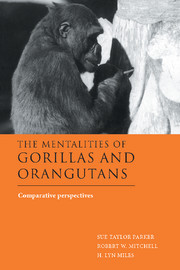Book contents
- Frontmatter
- Contents
- List of contributors
- Preface
- Acknowledgments
- I Comparative evolutionary and developmental perspectives on gorillas and orangutans
- II Cognition and tool use in gorillas and orangutans
- III Communication in gorillas and orangutans
- 10 Symbolic communication with and by great apes
- 11 The development of spontaneous gestural communication in a group of zoo-living lowland gorillas
- 12 Early sign-language acquisition: comparisons between children and gorillas
- 13 Early sign performance in a free-ranging,adult orangutan
- IV Social cognition in gorillas and orangutans
- V Epilogue
- Index of authors
- Index of subjects
13 - Early sign performance in a free-ranging,adult orangutan
Published online by Cambridge University Press: 20 October 2009
- Frontmatter
- Contents
- List of contributors
- Preface
- Acknowledgments
- I Comparative evolutionary and developmental perspectives on gorillas and orangutans
- II Cognition and tool use in gorillas and orangutans
- III Communication in gorillas and orangutans
- 10 Symbolic communication with and by great apes
- 11 The development of spontaneous gestural communication in a group of zoo-living lowland gorillas
- 12 Early sign-language acquisition: comparisons between children and gorillas
- 13 Early sign performance in a free-ranging,adult orangutan
- IV Social cognition in gorillas and orangutans
- V Epilogue
- Index of authors
- Index of subjects
Summary
INTRODUCTION
Young apes have been preferred subjects in language studies for a number of reasons. As dependent creatures, young apes engage in social behaviors which provide the interactive context in which many signs are learned. Young apes appear to learn certain behaviors more rapidly than older primates (Kawai, 1965). Young apes are also easier to handle and manage than older apes, who test their strength and dominance against caretakers as they enter adolescence (personal experience). Older apes are also stronger and potentially more dangerous than younger apes. Programs requiring close interaction, such as those carried out by ape language researchers, are more readily implemented when the subjects are young apes.
For these reasons sign-learning abilities in adult apes have not been as actively examined. Nevertheless, sign-learning abilities of adult apes should be of interest to those who study great ape cognitive or linguistic abilities. Likewise, although sign learning has not been studied in free-ranging apes, their motivation and ability to learn signs is of great interest. This chapter reports Project Rinnie, a study of the early sign-learning performance of an adult orangutan free-ranging within Tanjung Puting National Park (then a nature reserve).
METHODS
Subject
Rinnie, a captive-born, free-ranging female orangutan was approximately 10 to 12 years old at the onset of the Project. She was released as a rehabilitant at the Orangutan Research and Conservation Program (Galdikas, 1979) where she established a home range in a freshwater swamp forest across the river from the Camp Leakey Research Station. Rinnie was the oldest and the most dominant among the several ex-captive orangutans.
- Type
- Chapter
- Information
- The Mentalities of Gorillas and OrangutansComparative Perspectives, pp. 265 - 280Publisher: Cambridge University PressPrint publication year: 1999



